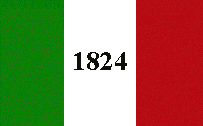This is some cool history that yet again, you just don’t hear about. I had no idea about this history, and after reading about it, I tried to collect as much as I could that talked about this little known subject. Just to set this up, here is an excerpt from wikipedia about what led up to this revolution or war of independence between Texas settlers and Mexico:
The Texas Revolution or Texas War of Independence was a military conflict between Mexico and settlers in the Texas portion of the Mexican state Coahuila y Tejas. The war lasted from October 2, 1835 to April 21, 1836. However, a war at sea between Mexico and Texas would continue into the 1840s. Animosity between the Mexican government and the American settlers in Texas, as well as many Texas residents of Mexican ancestry, began with the Siete Leyes of 1835, when Mexican President and General Antonio López de Santa Anna abolished the federal Constitution of 1824 and proclaimed the more centralizing 1835 constitution in its place.
The new laws were unpopular throughout Mexico, leading to violence in several states. War began in Texas on October 2, 1835, with the Battle of Gonzales. Early Texian Army successes at La Bahia and San Antonio were soon met with crushing defeat at the same locations a few months later. The war ended at the Battle of San Jacinto where General Sam Houston led the Texian Army to victory over a portion of the Mexican Army under Santa Anna, who was captured shortly after the battle. The conclusion of the war resulted in the creation of the Republic of Texas in 1836.
So I guess the thing that I wanted talk about with this particular piece of history, is the fact that privateering was the first act of the provisional government of Texas. They did not have a navy, so privateers was a quick and easy want to fire up a navy and put some money into the treasury by means of a prize court. Unfortunately at that time, Mexican commerce in the Gulf of Mexico was not that great, and thus a privateer industry or offense industry did not have the necessary elements to flourish.
It is also important to note that if Texas was not part of the US at the time, then this would be an example of another ‘country’ using the LoM. I could be wrong there, but I just do not know how to legally classify Texas at that time period? But either way, this is an example of a fledgling and resource strapped government, firing up the Letter of Marque as just one tool in their fight.
On a side note, the provisional government also handed out land to any soldiers who would fight for Texas Independence. This is an interesting concept, and I wonder if Somalia could do something similar? Hell, the TFG could fire up the LoM as well, and grant these licenses to foreign or local privateers to go after pirates on water and land. Meaning, if a company could seize by force the wealth of the pirate investors or pirates themselves, then that company would split that prize with the TFG. That puts money into the treasury of the TFG, it provides financial incentive to the privateer companies, and it creates an offense industry that profits from piracy’s destruction. To really fire it up, they could offer pirates amnesty if they become privateers for the government. Call it the Woodes Rogers solution. lol.
Either way, check it out and let me know what you think. I think that flag below would be a cool morale patch for today’s maritime security bunch too. And I know that Texas is not ‘legally’ authorized to grant LoM’s at this present time, but imagine if they were? That they created an offense industry to deal with the asset rich cartels that operate along the borders? Now that would be something else. –Matt

The flag that Texas Privateers were required to fly on their vessels.
(From the Texas State Library and Archives Commission)
Revolution broke out in earnest in Texas in October 1835 with the seizure of the Mexican cannon at Gonzales and the beginning of the Siege of Bexar. As these events unfolded, the Consultation, the first revolutionary assembly of Texas, came together in San Felipe on November 3, 1835. One of its first acts was to consider the protection of the Texas coast. It was impossible to create a Navy overnight, so the Texans adopted the time-honored practice of issuing letters of marque and reprisal to privateers. These privately owned war ships would protect the coast, harass Mexican shipping, and bring in prizes that could be auctioned off, with part of the proceeds going into the public treasury.
Texas issued a total of six letters of marque to privateers, including the San Felipe, the William Robbins, the Terrible, the Thomas Toby, the Flash, and the Ocean. Flying the “1824” Texas Revolutionary flag, these ships not only patrolled the Gulf, but also pursued Mexican shipping on the high seas. The Thomas Toby was the outstanding privateer of the group, capturing several Mexican vessels and bringing them back to be adjudicated and their contents sold. Overall, though, the privateering effort was disappointing for Texas. Mexican shipping was not considered rich trade, so relatively few privateers were willing to take the risk.